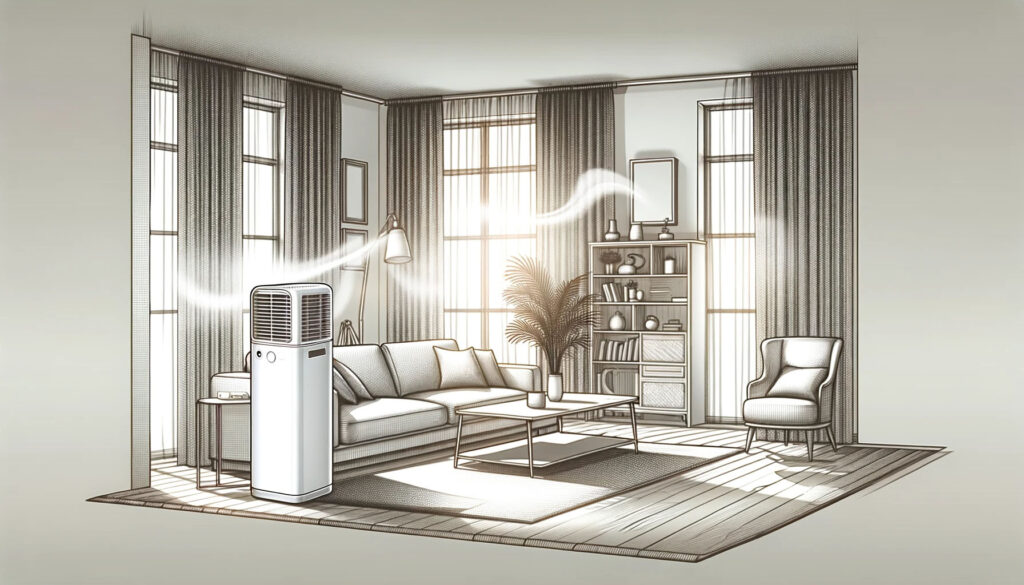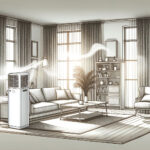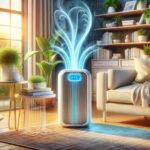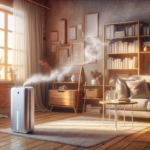Air purifiers have become essential tools in our quest for cleaner, healthier indoor environments. They work tirelessly to filter out pollutants, allergens, and other airborne irritants that compromise air quality. However, their effectiveness is not just about their technical capabilities; it’s also significantly influenced by where they are placed within a room. The struggle to pinpoint the optimal location for these devices stems from a variety of factors, including room layout, air flow patterns, and the types of pollutants present.
The challenge of positioning an air purifier effectively is compounded by the diverse nature of indoor spaces. Each room, whether it’s a bustling living room, a peaceful bedroom, or a busy kitchen, presents its own set of air quality issues. These range from external pollution seeping in through doors and windows, to internal sources like cooking fumes and electronic devices. Additionally, the physical design of a room – its size, the presence of furniture, and the arrangement of ventilation systems – plays a crucial role in how well an air purifier can perform its job.
Understanding the dynamics of air movement and the nature of airborne pollutants is key to maximizing the benefits of an air purifier. By strategically placing these devices in areas where they can operate most efficiently, we can enhance their performance, ensuring cleaner air and a healthier living environment.
Key Considerations for Air Purifier Placement
Avoid Placement Near Electronics (for Ionic Purifiers)
When setting up an ionic air purifier, it’s crucial to consider its proximity to electronic devices. Ionic air purifiers function by emitting charged particles into the air. These particles attach to air pollutants, causing them to settle on nearby surfaces. This process can lead to an unintended side effect – the accumulation of dust and pollutants on electronic devices if the purifier is placed too close to them. For instance, if an ionic purifier is situated near a computer or television, there’s a risk that these devices might attract a significant amount of this settled dust, potentially leading to damage or impaired function.
Consider the example of a study room with a computer and other electronic gadgets. If an ionic air purifier is placed within close range of these devices, over time, layers of dust might accumulate, necessitating frequent cleaning and potentially leading to overheating or damage to the electronics. Therefore, it’s advisable to place ionic purifiers at a safe distance from such devices, ensuring both efficient air purification and the longevity of your electronic equipment.
Room Size and Air Purifier Capacity
The effectiveness of an air purifier is closely tied to its compatibility with the room size. This is where the Clean Air Delivery Rate (CADR) comes into play. CADR is a metric that indicates the volume of filtered air an air purifier can deliver per minute. Essentially, a higher CADR rating means the purifier can filter air more quickly, making it suitable for larger spaces. When choosing an air purifier, it’s important to select one whose CADR matches or exceeds the requirements of the room.
For example, in a large living room, a purifier with a high CADR is essential to ensure that the entire space is adequately serviced. Conversely, for a smaller bedroom, a purifier with a lower CADR might be sufficient. To illustrate, let’s consider a room of 300 square feet. Ideally, the air purifier for this room should have a CADR rating that’s at least two-thirds of the room’s area, ensuring it can effectively circulate and clean the air within that space.
When assessing the right air purifier, it’s also helpful to consider the types of pollutants predominant in your area. For instance, if you live in an area with high pollen counts, a purifier with a higher CADR for pollen would be more beneficial. Similarly, in urban areas with higher smoke or dust particles, a purifier with a higher CADR for these specific pollutants would be more effective.
Placeholder for Image: “Comparison of air purifiers with different CADR ratings in various room sizes”
By considering these key aspects, you can ensure that your air purifier is not just a functional addition to your space, but an optimized solution for cleaner, healthier air.
Optimal Placement in Different Rooms
Living Room
Proximity to Air Entry Points
Placing an air purifier near windows or doors in the living room is strategic, as these are common entry points for external pollutants. This placement allows the purifier to tackle contaminants right as they enter, preventing them from circulating throughout the room.
Sizing Matters
The size of the air purifier should correspond with the size of the living room. A larger room requires a purifier with higher capacity to ensure effective air cleaning. It’s essential to match the purifier’s clean air delivery rate (CADR) with the room’s volume.
Central Positioning
For optimal effectiveness, position the air purifier between the center of the room and seating areas. This placement ensures widespread air purification while benefiting the occupants directly, especially in areas where they spend the most time.
Bedroom
Near the Sleeping Area
In the bedroom, the purifier should be placed close to the bed, ideally within your breathing zone while sleeping. This ensures the air you breathe throughout the night is as clean as possible, providing better sleep quality.
Airflow Direction
Direct airflow from the purifier should not be aimed at the bed to prevent excessive skin dryness. Adjusting the direction of airflow can mitigate this while maintaining air purification efficiency.
Safe Distance from Heat Sources
Keep the air purifier away from heaters and ensure there’s enough clearance from walls. This placement avoids any interference with the purifier’s functioning and ensures proper air circulation around the unit.
Kitchen
Capturing Kitchen Contaminants
In the kitchen, place the air purifier where it can best intercept cooking odors and byproducts. This can be near the stove or other areas where food is prepared, allowing the purifier to capture pollutants at their source.
Additional Tips
Avoiding Obstructions
Ensure that the air purifier is not blocked by furniture or other obstacles. This allows for unobstructed air intake and output, maximizing the purifier’s efficiency.
Regular Maintenance
Regularly clean and replace filters as recommended by the manufacturer. This ensures that the purifier operates at peak efficiency, regardless of its location in the room.
Monitoring Air Quality
Consider using an air quality monitor alongside the purifier. This device can help you understand the effectiveness of the purifier in real-time and adjust its placement if necessary.
Placeholder for Image: “Air purifier in a modern living room, showing ideal placement near a window and away from obstructions.”
By following these guidelines, you can optimize the placement of your air purifier in various rooms, ensuring maximum efficiency in purifying the air you breathe in your home.
General Placement Tips
Elevate the Purifier
Raising your air purifier off the ground, ideally between 3 to 5 feet, significantly enhances its efficiency. This elevation aligns the purifier more closely with the breathing zone of most adults, ensuring that the filtered air is more effectively dispersed throughout the room. For instance, positioning a purifier on a sturdy table or a dedicated stand can improve its floor-to-ceiling ventilation, capturing pollutants that tend to hover at different heights. This strategy is particularly effective in rooms with high ceilings or in areas where pollutants like smoke or cooking fumes rise.
Avoid Corners and Obstacles
Air purifiers placed in corners or close to obstacles face a major reduction in their effectiveness. Corners typically have the lowest airflow in a room, limiting the purifier’s ability to draw in unfiltered air. Similarly, obstacles like furniture or curtains can block air from reaching the purifier. It’s advisable to maintain at least a 3-foot clearance around the purifier to ensure unobstructed airflow. Think of your purifier like a plant needing sunlight; without proper exposure to air, it can’t thrive.
High Airflow Areas
Strategically placing air purifiers near windows or doorways leverages natural air currents, enhancing the purifier’s ability to capture incoming pollutants. This placement acts as a first line of defense against outdoor contaminants like pollen or vehicle exhaust. Especially during seasons with high pollen counts or in urban areas with heavy traffic, positioning purifiers close to these entry points can significantly reduce the influx of outdoor pollutants.
Regular Maintenance and Filter Replacement
Beyond placement, regular maintenance of your air purifier is crucial. Filters should be replaced according to the manufacturer’s guidelines, as a clogged or dirty filter drastically reduces the purifier’s efficiency. For instance, HEPA filters, commonly used in many purifiers, need to be replaced every 6-12 months depending on usage. Regularly checking and cleaning the air intake and exhaust vents also ensures optimal performance.
Consider Room Dynamics
The layout and usage of a room should influence where you place your purifier. In a bedroom, for instance, placing the pur
Elevate the Purifier
Raising your air purifier off the ground, ideally between 3 to 5 feet, significantly enhances its efficiency. This elevation aligns the purifier more closely with the breathing zone of most adults, ensuring that the filtered air is more effectively dispersed throughout the room. For instance, positioning a purifier on a sturdy table or a dedicated stand can improve its floor-to-ceiling ventilation, capturing pollutants that tend to hover at different heights. This strategy is particularly effective in rooms with high ceilings or in areas where pollutants like smoke or cooking fumes rise.
Avoid Corners and Obstacles
Air purifiers placed in corners or close to obstacles face a major reduction in their effectiveness. Corners typically have the lowest airflow in a room, limiting the purifier’s ability to draw in unfiltered air. Similarly, obstacles like furniture or curtains can block air from reaching the purifier. It’s advisable to maintain at least a 3-foot clearance around the purifier to ensure unobstructed airflow. Think of your purifier like a plant needing sunlight; without proper exposure to air, it can’t thrive.
High Airflow Areas
Strategically placing air purifiers near windows or doorways leverages natural air currents, enhancing the purifier’s ability to capture incoming pollutants. This placement acts as a first line of defense against outdoor contaminants like pollen or vehicle exhaust. Especially during seasons with high pollen counts or in urban areas with heavy traffic, positioning purifiers close to these entry points can significantly reduce the influx of outdoor pollutants.
Regular Maintenance and Filter Replacement
Beyond placement, regular maintenance of your air purifier is crucial. Filters should be replaced according to the manufacturer’s guidelines, as a clogged or dirty filter drastically reduces the purifier’s efficiency. For instance, HEPA filters, commonly used in many purifiers, need to be replaced every 6-12 months depending on usage. Regularly checking and cleaning the air intake and exhaust vents also ensures optimal performance.
Consider Room Dynamics
The layout and usage of a room should influence where you place your purifier. In a bedroom, for instance, placing the purifier near the bed can provide cleaner air during sleep, which is essential given the hours spent in this space. In contrast, a living room might benefit from a central location where people spend most of their time, or near a frequently used entrance to filter incoming air.
Avoid Direct Airflow on Sensitive Areas
Direct airflow from an air purifier can be uncomfortable and potentially harmful. For example, direct airflow on plants can dry them out, and in the bedroom, it can cause dry skin or irritate eyes. Position the purifier to avoid direct airflow on such sensitive areas or living beings.
Adjust Placement as Needed
Remember, the optimal placement for your air purifier may change depending on various factors such as season, room rearrangement, or even the introduction of new household items or pets. Periodically reassessing the placement and making adjustments can help maintain optimal air quality.
By following these guidelines, you can ensure your air purifier works at its best, contributing to a healthier and more comfortable indoor environment.
Conclusion
Air purifiers are vital in our pursuit of cleaner, healthier air indoors, but their effectiveness hinges on more than just their technical specs. The key to maximizing their benefits lies in thoughtful placement, taking into account room dynamics and various other factors. Let’s recap the essential takeaways to help you position your air purifier for optimal performance:
- Placement Relative to Electronics: For ionic purifiers, maintain a safe distance from electronic devices to prevent dust accumulation and potential damage.
- Room Size vs. Air Purifier Capacity: Choose an air purifier with a Clean Air Delivery Rate (CADR) that matches or exceeds the size of your room. This ensures efficient air circulation and filtration.
- Strategic Placement in Different Rooms: Tailor the purifier’s location to the specific needs of each room:
- In living rooms, place near air entry points like windows or doors, and ensure the size matches the room’s volume.
- In bedrooms, position close to the bed but avoid direct airflow to prevent dryness.
- In kitchens, locate near cooking areas to effectively capture food odors and byproducts.
- Avoiding Obstructions: Ensure the air purifier is not blocked by furniture or other items for unimpeded air intake and output.
- Regular Maintenance: Clean and replace filters as recommended to maintain peak efficiency.
- Elevation of the Purifier: Elevate the purifier between 3 to 5 feet off the ground to align with the adult breathing zone, improving air dispersal.
- Avoiding Corners and Obstacles: Place the purifier in areas with high airflow, away from corners and obstacles, to enhance its air intake capacity.
- High Airflow Areas: Position near windows or doorways to capture incoming pollutants effectively.
- Regular Maintenance and Filter Replacement: Adhere to maintenance schedules for filters and check air vents regularly.
- Adjusting to Room Dynamics: Consider the specific layout and use of each room for optimal placement.
- Avoid Direct Airflow on Sensitive Areas: Position the purifier to prevent discomfort or harm to plants, pets, or people.
- Flexibility in Placement: Be prepared to adjust the purifier’s location based on changes in the room or different seasons.
By implementing these guidelines, you ensure that your air purifier not only functions efficiently but also contributes significantly to a healthier and more comfortable indoor environment. Remember, the right placement can drastically enhance the purifier’s performance, making it a more effective tool in your quest for clean air.







